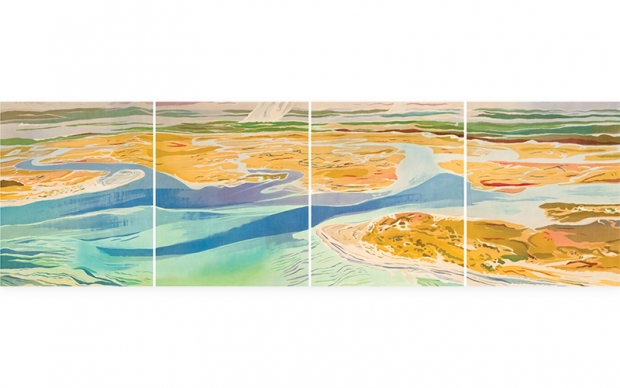Mary Edna Fraser, batik on silk, 48 x 144 inches, collection of The Belle W. Baruch Foundation, Hobcaw Barony

If you’ve ever flown over the southeastern coastline, you may have found yourself in utter delight and awe at the exquisite aerial views of the intricate network of winding creeks and rivers that empty out into the seemingly unending vastness of the ocean. The indescribable wonder of our magical, watery landscape seen from above is humbling. It allows us perspective and, for many, instills gratitude for the beauty of the natural surroundings of the world we inhabit. It is this very perception that master dyer and environmentalist Mary Edna Fraser so magnificently captures with her work in both batik and oil. Myrtle Beach’s Franklin G. Burroughs-Simeon B. Chapin Art Museum will feature the exhibition Mary Edna Faser: Awakening through May 18.
Working out of her gorgeous—and very zen—studio on James Island that backs up to a tidal creek with the most beautiful view, Fraser is able to create the world’s largest batiks. “The process is labor intensive but beautifully meditative,” says Fraser. The artist’s creations typically begin and are inspired by a flight in her family’s vintage plane over the area that she intends to capture on silk, canvas or linen. From the open cockpit, Fraser photographs the views from above, which will eventually be translated into dreamy batiks and paintings. Fraser also spends significant time on site on the ground photographing and plein-air painting as part of her process. Back in the studio, she transposes these captured scenes into what she calls visual poetry.
Inspired greatly by the flattened forms and bold color palettes of Japanese prints and scrolls from the Edo era, as well as the Impressionists, like Bonnard, Monet, Van Gogh and Vuillard who, too, were influenced by Japonisme, Fraser approaches her silks and canvases by abstracting her subjects into meditative and expressive visual representations. In other words, she merges abstraction, expressionism and realism to form her unique painterly style.
Fraser remarks, “For a half century as an environment activist artist, my art communicates messages of conservation and stewardship. Large-scale oils painted on location help protect sacred landscapes. Aerial and satellite photography, maps and charts inform explorations which reveal complex patterns. The artworks have elegant impact by virtue of scale, compelling design and vibrant color.” Mary Edna Fraser: Awakening features close to 60 of Fraser’s works in tremendous, flowing batiks on silk and expansive, colorful landscapes in oil, along with short educational STEAM videos that bring local environmentally threatened areas—that are the subject of her work—to the viewer’s attention.
Fraser grew up in Fayetteville, N.C. She attended East Carolina University (Greenville, N.C.), where she double-majored in clothing and textiles and interior design. She pursued graduate courses at Arrowmont School of Crafts (Gatlinburg, Tenn.), where she learned resist and direct dying techniques with Sister Mary Remy Revor (1914-1998) and Lenore Davis (1936-1995), respectively. Fraser then went on to study with master dyers Chunghi Choo (b.1938) and Ed Lambert (d.2011) at the University of Georgia (Athens, Ga.).
With over 100 one-woman exhibitions, including the Smithsonian National Air and Space Museum’s (Washington, D.C.) first textile show, as well as its first solo exhibition by a woman; her work included in prestigious collections; and a lengthy list of honors and awards, Mary Edna Fraser is a true South Carolina icon and one who is passionately dedicated to her craft and to the survival of our planet. The Art Museum is thrilled to present Mary Edna Fraser: Awakening. May it awaken a sense of pride and duty to the protection of our natural world for generations to come.